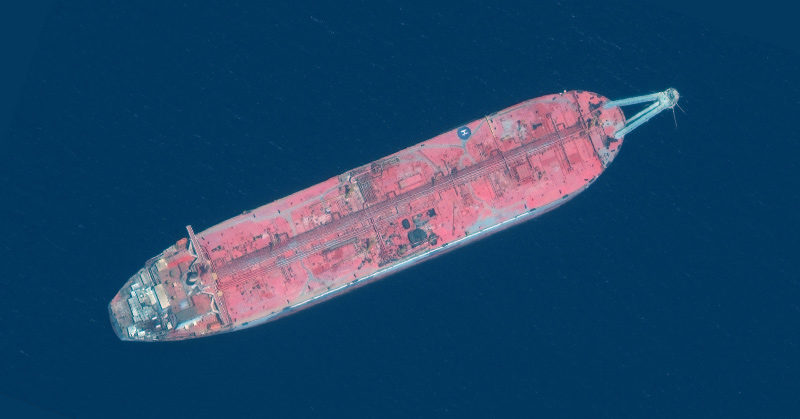On March 24, 1989, The Exxon Valdez oil tanker struck a reef off the coast of Alaska. The hull of the ship was torn open, and eleven million gallons of crude oil spilled out into the ocean. More than one thousand miles of coastline were damaged, and hundreds of thousands of animals were killed. Still to this day, many Alaskan beaches remain polluted [1].
Today a deteriorating oil tanker off the coast of Yemen, the FSO Safer, is on the brink of an even worse disaster. The ship contains four times as much oil as the Exxon Valdez, and if it is not removed from the damaged ship threatens to spill into the water and destroy ecosystems [2].
The UN: We’re Running Out of Time
United Nations environment chief Inger Anderson says that a disaster such as this could wreck ecosystems and livelihoods for decades to come, and that their only option is to prevent it from happening.
“Despite the difficult operational context, no effort should be spared to first conduct a technical assessment and initial light repairs,” she told the UN Security Council [2].
The oil tanker, which has not been maintained for over five years, could release 1.1 million barrels of crude oil into the ocean, and Anderson is urging the international community to come up with a response plan in case an oil spill occurs.
“Time is running out for us to act in a coordinated manner to prevent a looming environmental, economic and humanitarian catastrophe,” she said [2].
The Associated Press obtained internal documents one month ago showing that sea water had entered the engine compartment of the tanker. Pipes have been damaged, and rust has covered parts of the tanker. The inert gas that prevents tankers from gathering inflammable gases has leaked out, and has increased the risk of the ship sinking.
The ship is so damaged that experts say maintenance is no longer possible, and UN humanitarian affairs chief Mark Lowcock said that the leaking tanker has brought us closer than ever to an environmental catastrophe [2].
The ship was sold to the Yemeni government from Japan in the 1980s to store up to three million barrels pumped from oil fields in the Mareb province before being exported. At 360 meters long, it contains 34 storage tanks [2].
Resistance from Rebels
The trouble is that the UN needs permission to operate before inspectors can assess the ship’s damage and look for ways to secure the tanker, unload the oil, and pull the ship to safety. They are having difficulty obtaining that permission because the area where the ship is moored is controlled by Houthi rebels, who have been denying UN access to the ship [2].
The Houthi rebels are a broad tribal alliance in the North of Yemen that emerged in the 1980s. They have a heavy anti-imperial ideology, and in particular do not like Israel, the United States, and Saudi Arabia. The UN has identified that the war that erupted in 2014 when Shiite Houthi rebels launched a campaign to capture the nation’s capital, Sanaa, is the root cause of the current disaster occurring in Yemen [3].
In August, the rebels said they would approve a UN mission to inspect the ship, only to cancel it the night before the visit was planned. They have recently said they would approve another mission, but UN officials are skeptical.
Lowcock is urging the rebels to “take steps that will spare millions of their fellow citizens from yet another tragedy” [2].
Lessons from Russia
Last month, Britain’s ambassador to Yemen used another fuel leak disaster as a comparison to the FSO Safer, showing just how much damage a leaking oil tanker can do.
In May, more than 21 thousand tonnes of fuel was released when a fuel reservoir collapsed in the Arctic circle, and Siberian officials have warned it will take years to clean it up. The spill has already killed wildlife, and the pollution could now flow into the Kara sea north of Siberia, which Greenpeace Russia expert Vladimir Chuprov said would be a “disaster” [4].
The reservoir in Siberia contained twenty thousand tonnes of fuel. The oil tanker in Yemen contains 150 tonnes of oil, which would devastate the Red Sea [2].
UN spokesman Stephane Dujarric says that the UN is fully mobilized, and once they have the permissions they need they will move as fast as possible.
“We have been flagging this issue for quite some time to make sure that it is not on the back burner but it is on the front burner and everybody is paying attention to it,” he said. “But I can assure you that our colleagues are working as quickly as possible” [2].
Keep Reading: Chernobyl shocker as fungi that eats radiation found inside nuclear reactor
- https://www.theatlantic.com/photo/2014/03/remembering-the-exxon-valdez-oil-spill/100703/
- https://www.cbsnews.com/news/fso-safer-tanker-could-spill-4-times-more-oil-than-exxon-valdez-yemen/
- https://www.dw.com/en/yemens-houthi-rebels-who-are-they-and-what-do-they-want/a-50667558
- https://www.theguardian.com/environment/2020/jun/10/three-arrested-over-huge-fuel-spill-in-the-arctic-circle

